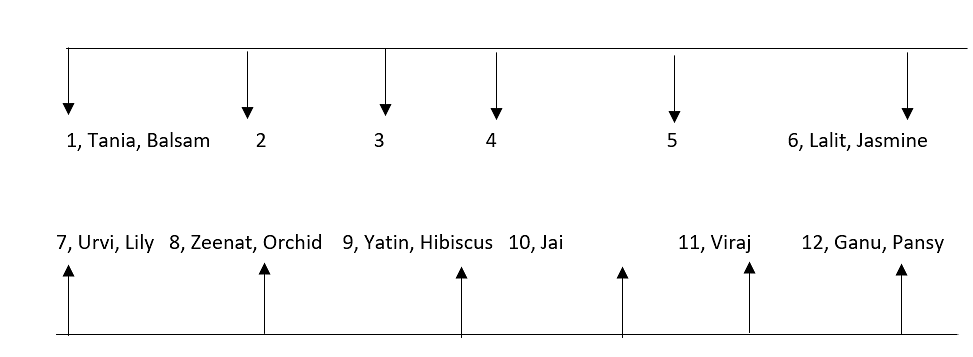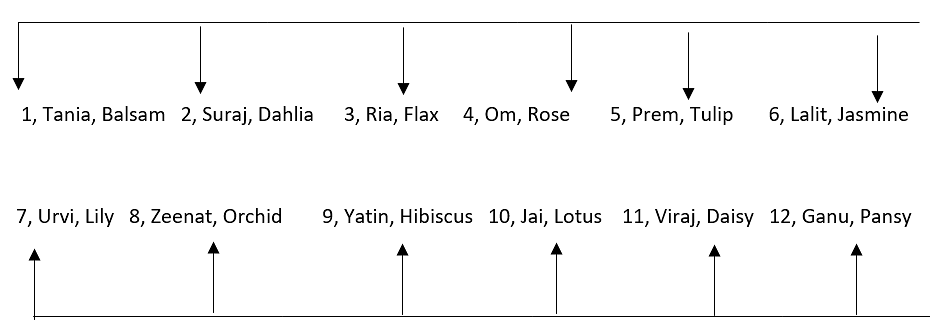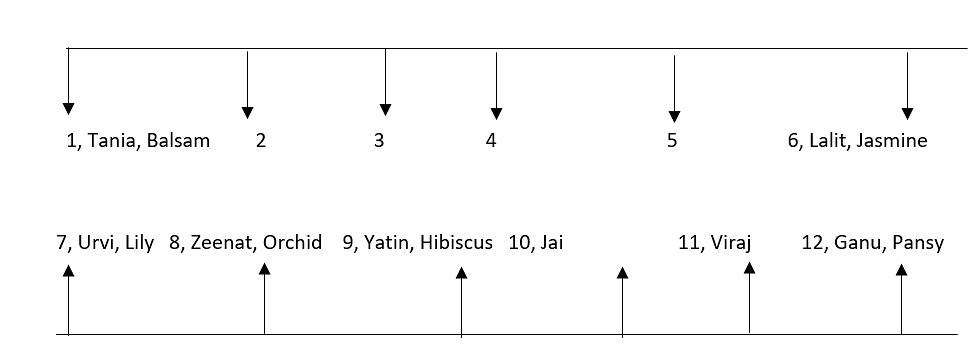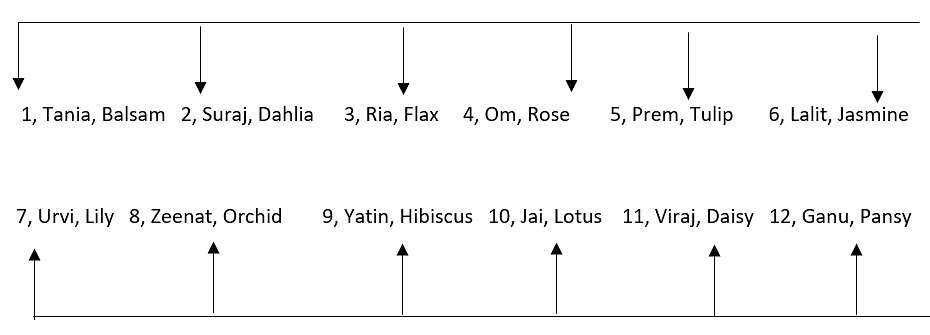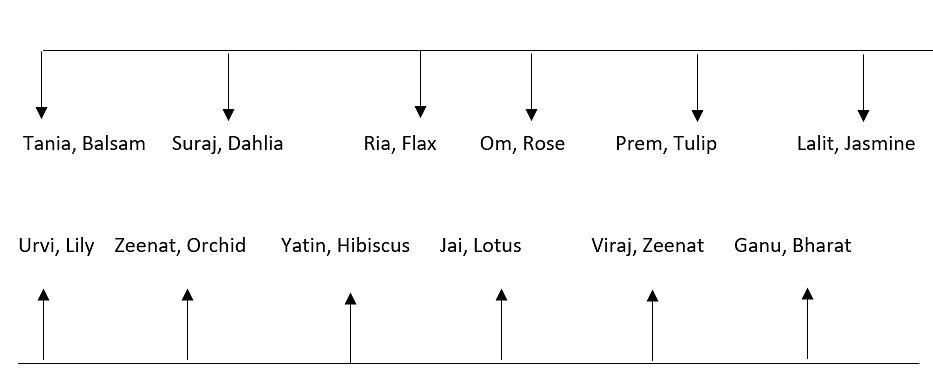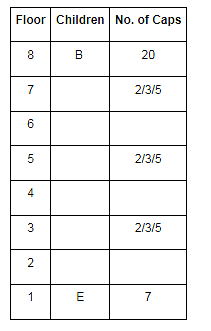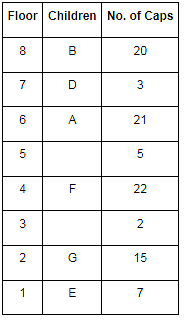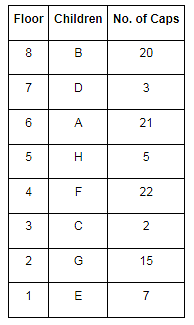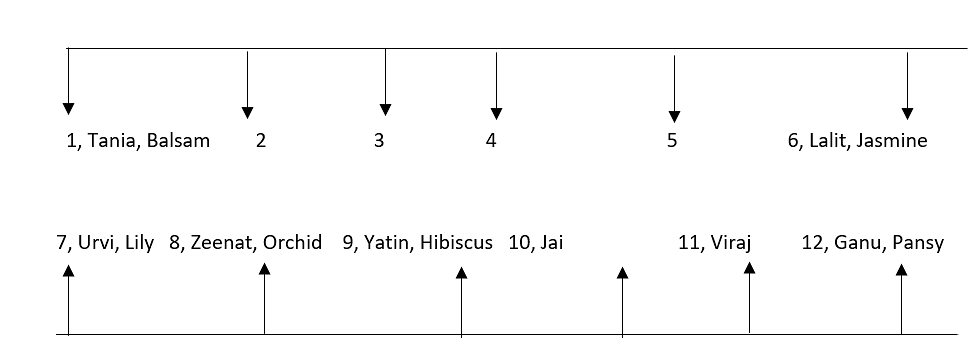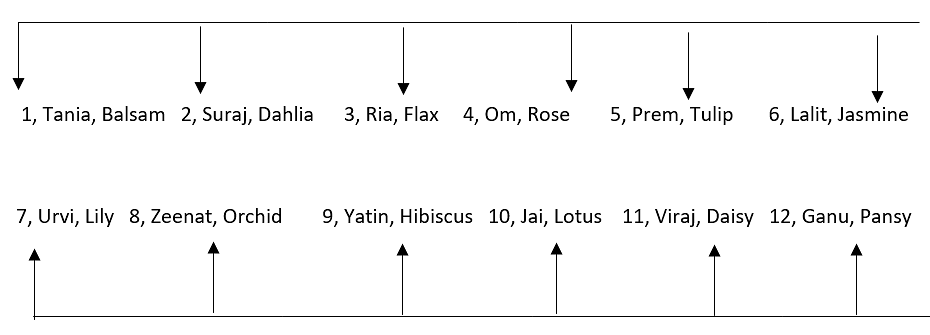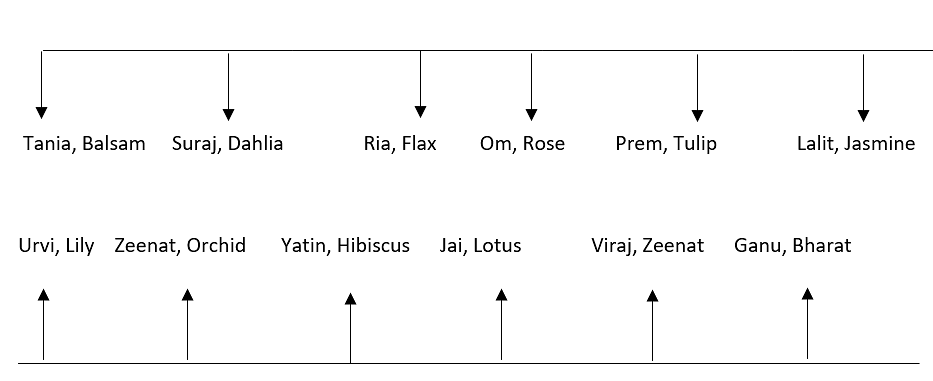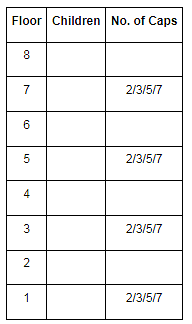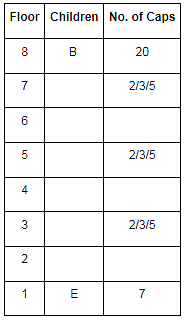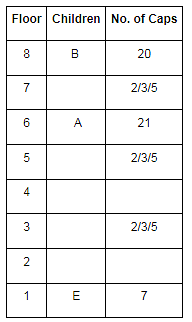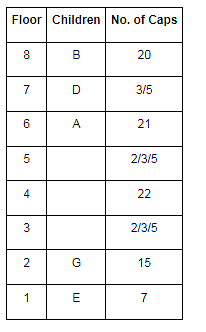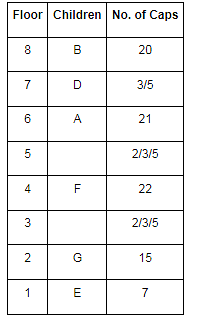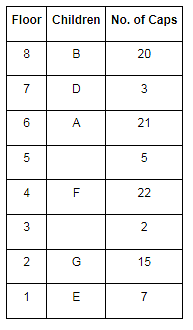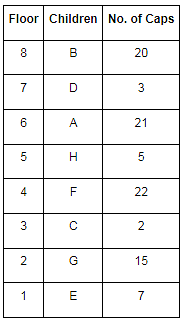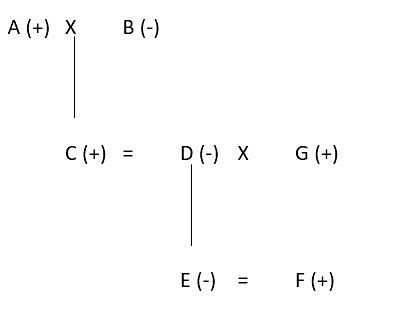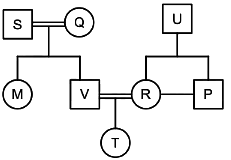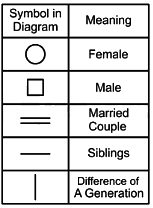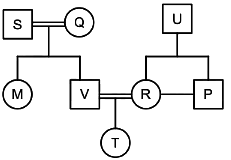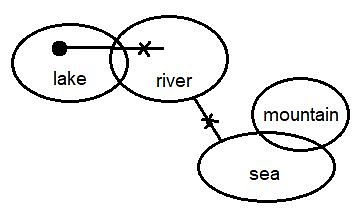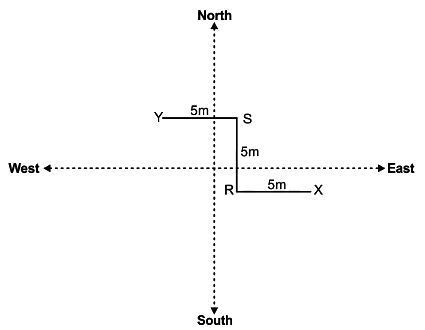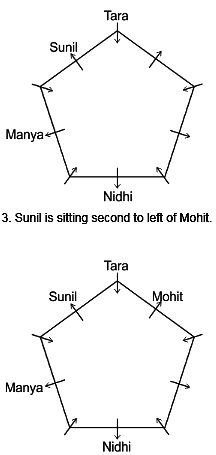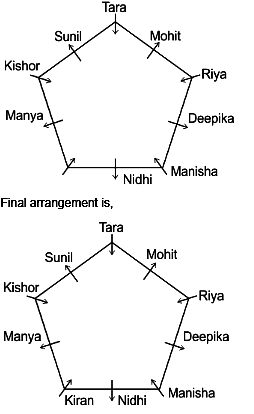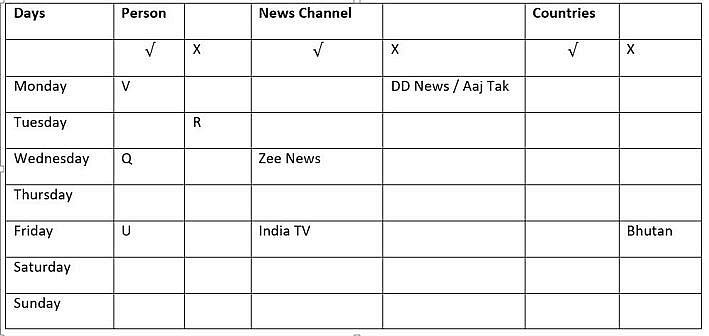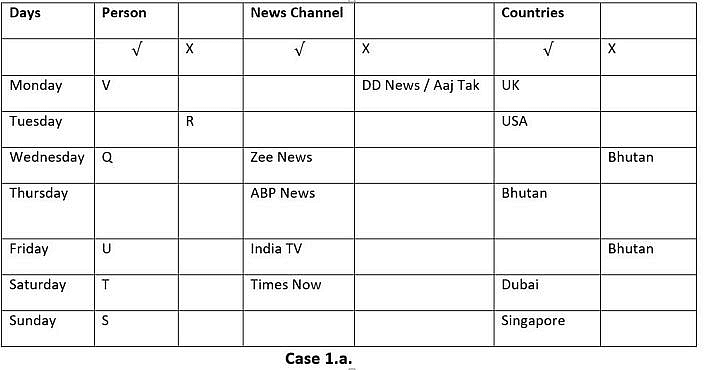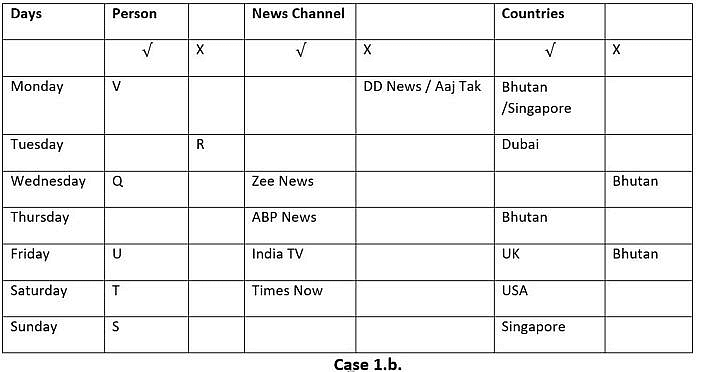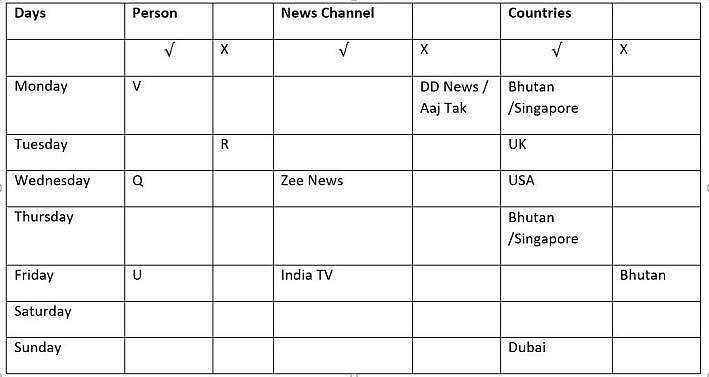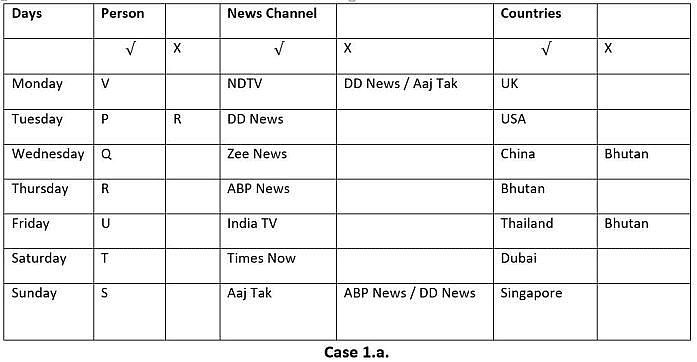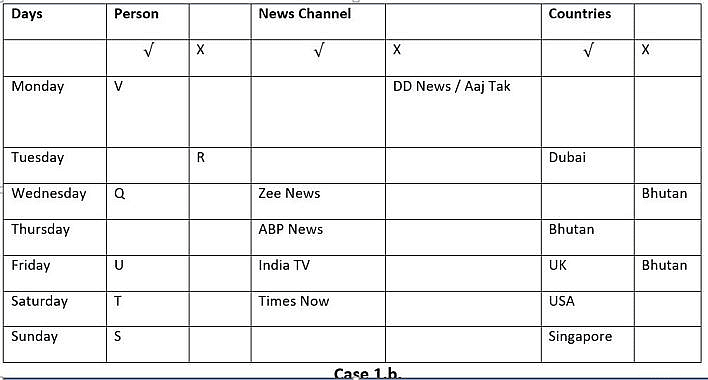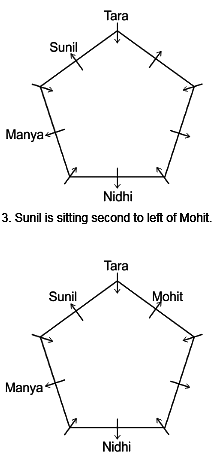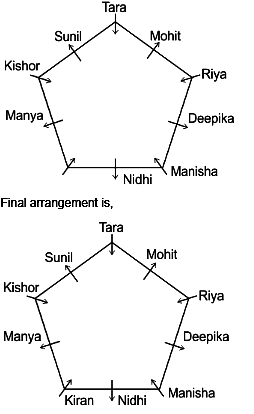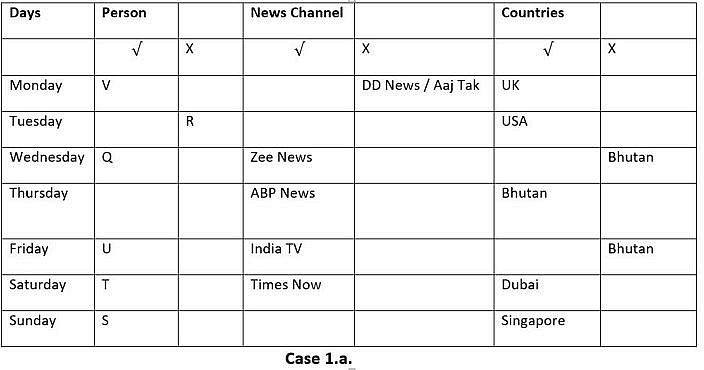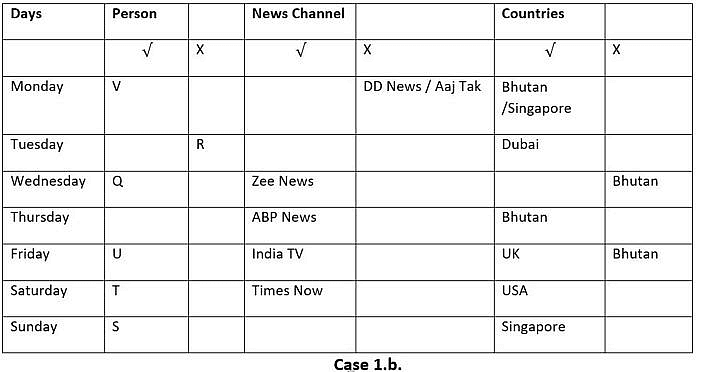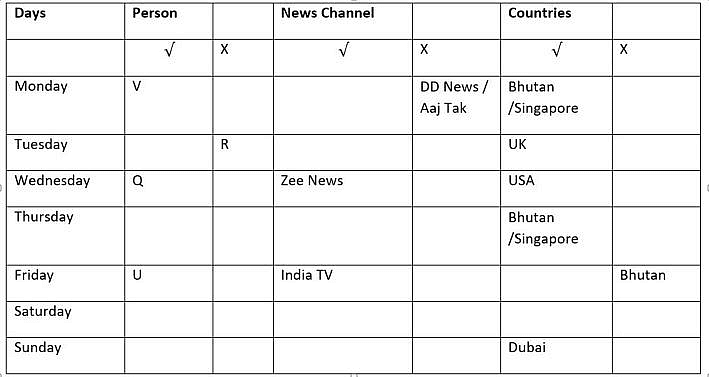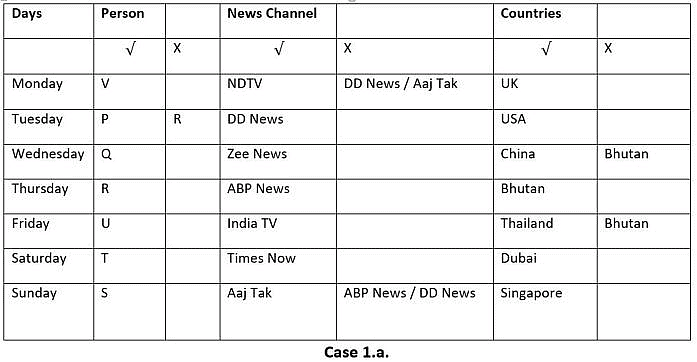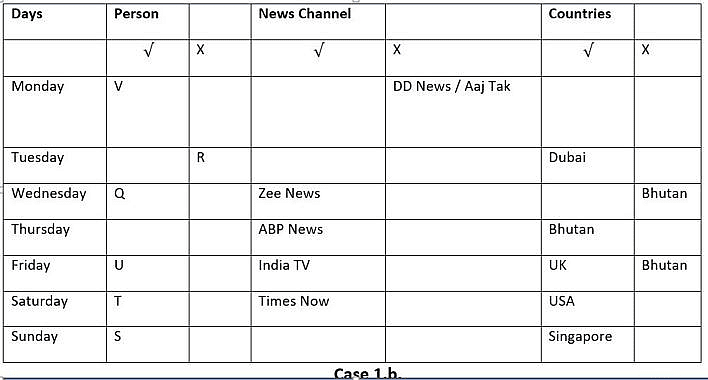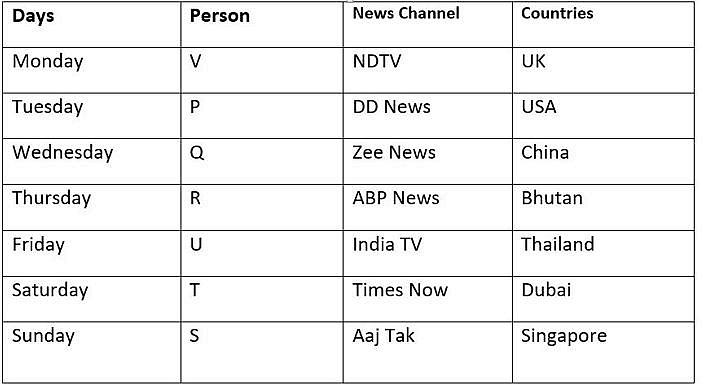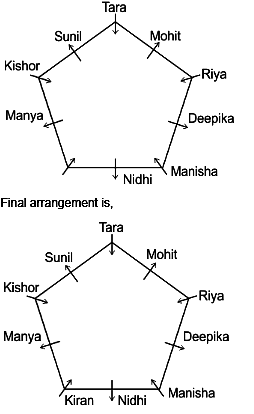NABARD Assistant Manager Grade 'A' Mock Test - 9 - Bank Exams MCQ
30 Questions MCQ Test - NABARD Assistant Manager Grade 'A' Mock Test - 9
Read the following information carefully and answer the questions given below.
Twelve friends are seated along the two rows - (such that facing each other.) and they all likes different flowers. Om, Prem, Lalit, Ria, Suraj and Tania are seated in first row and facing south. Urvi, Viraj, Ganu, Jai, Yatin and Zeenat are seated in second row and facing north.
(i) Om likes Rose flower and faces the one who likes Lotus. Viraj is on the immediate right of Jai who is facing Om. Viraj, Suraj, and Prem like daisy, Dahlia and Tulip flower respectively.
(ii) Ria is on the immediate right of Om. Urvi, Ganu, Tania and Lalit are at extreme ends and nobody is seated on the right of Tania. Ganu and Urvi like Pansy and Lily respectively. Urvi sits with the one who likes Orchid flower.
(iii) Only Zeenat is seated between Urvi and Yatin and he is not facing Prem. Yatin and Ria likes Hibiscus and Flax flower respectively. Viraj is on the immediate left of Ganu.
(iv) The one who sits extreme left of row 1 likes Jasmine and the one who sits at another end in same row likes Balsam flower.
Q. Who likes Orchid flower?
Direction: In the question below are given three statements follows ed by three conclusions numbered I, II, and III. You have to take the given statements to be true even if they seem to be at variance with commonly known facts. Read all the conclusions and then decide which of the given conclusions logically follows s from the given statements disregarding commonly known facts.
Statements:
Only a few person is lazy.
Some lazy is good.
All good is happy.
Conclusions:
I. All lazy is person.
II. Some lazy is happy.
III. Some Good are person.
| 1 Crore+ students have signed up on EduRev. Have you? Download the App |
Read the following information carefully and answer the questions given below.
Twelve friends are seated along the two rows - (such that facing each other.) and they all likes different flowers. Om, Prem, Lalit, Ria, Suraj and Tania are seated in first row and facing south. Urvi, Viraj, Ganu, Jai, Yatin and Zeenat are seated in second row and facing north.
(i) Om likes Rose flower and faces the one who likes Lotus. Viraj is on the immediate right of Jai who is facing Om. Viraj, Suraj, and Prem like daisy, Dahlia and Tulip flower respectively.
(ii) Ria is on the immediate right of Om. Urvi, Ganu, Tania and Lalit are at extreme ends and nobody is seated on the right of Tania. Ganu and Urvi like Pansy and Lily respectively. Urvi sits with the one who likes Orchid flower.
(iii) Only Zeenat is seated between Urvi and Yatin and he is not facing Prem. Yatin and Ria likes Hibiscus and Flax flower respectively. Viraj is on the immediate left of Ganu.
(iv) The one who sits extreme left of row 1 likes Jasmine and the one who sits at another end in same row likes Balsam flower.
Q. If Suraj is related to Yatin in a certain way and Om is related to Viraj in the same way, then which of the following is related to Tania?
Direction: Read the following information carefully and answer the questions given below.
Eight children A, B, C, D, E, F, G and H live in an eight-floor building. Each of them has 2, 3, 5, 7, 15, 20, 21 and 22 caps of different types but not necessarily in the same order. Floor 1 is the ground floor and 8 is the topmost floor. B lives on the topmost floor and E on the ground floor and one of them has 20 caps and other one have 7. A have a number of caps which is the product of two odd prime numbers but greater than 20 and lives on a floor which is third from the top. D lives above A and doesn't have the least number of caps. F lives exactly between A and G. Child living at floor number 5 have the same number of caps as his floor number. Children living on the odd-numbered floor have caps in a prime number. H lives above C. G live on floor number 2 and don't have caps which are a multiple of 11.
Q. Who lives immediately above G?
Read the following information carefully and answer the questions given below.
Twelve friends are seated along the two rows - (such that facing each other.) and they all likes different flowers. Om, Prem, Lalit, Ria, Suraj and Tania are seated in first row and facing south. Urvi, Viraj, Ganu, Jai, Yatin and Zeenat are seated in second row and facing north.
(i) Om likes Rose flower and faces the one who likes Lotus. Viraj is on the immediate right of Jai who is facing Om. Viraj, Suraj, and Prem like daisy, Dahlia and Tulip flower respectively.
(ii) Ria is on the immediate right of Om. Urvi, Ganu, Tania and Lalit are at extreme ends and nobody is seated on the right of Tania. Ganu and Urvi like Pansy and Lily respectively. Urvi sits with the one who likes Orchid flower.
(iii) Only Zeenat is seated between Urvi and Yatin and he is not facing Prem. Yatin and Ria likes Hibiscus and Flax flower respectively. Viraj is on the immediate left of Ganu.
(iv) The one who sits extreme left of row 1 likes Jasmine and the one who sits at another end in same row likes Balsam flower.
Q. If in the first row first person from the left interchange its position with the sixth person from the left and following the same way second person changes its position with fifth and third person change its position with fourth and so on, who will face ‘Zeenat’?
Direction: Read the following information carefully and answer the questions given below.
Eight children A, B, C, D, E, F, G and H live in an eight-floor building. Each of them has 2, 3, 5, 7, 15, 20, 21 and 22 caps of different types but not necessarily in the same order. Floor 1 is the ground floor and 8 is the topmost floor. B lives on the topmost floor and E on the ground floor and one of them has 20 caps and other one have 7. A have a number of caps which is the product of two odd prime numbers but greater than 20 and lives on a floor which is third from the top. D lives above A and doesn't have the least number of caps. F lives exactly between A and G. Child living at floor number 5 have the same number of caps as his floor number. Children living on the odd-numbered floor have caps in a prime number. H lives above C. G live on floor number 2 and don't have caps which are a multiple of 11.
Q. How many caps do child living at floor numbered 2 have?
Study the following information to answer the given questions.
There are seven members of a family of three generations and two are married couples. A is the father-in-law of G. C is the only son of B. There are two children of D, who is married to brother-in-law of C. E is not the son of G. F is the grandson of the husband of B.
Q. Who is the daughter of Husband of B?
Direction: Study the following information carefully and answer the question given below.
There are seven members in the family P, Q, R, S, T, U, and V. P is the only son of U and brother of R. S is the father-in-law of R. T is the only daughter of R. V is the son of Q who is the grandmother of T. U is the maternal grandfather of T and father-in-law of V.
Q. If M is the sister of V, then what is the relation of M with R?
In each question below are given some statements followed by some conclusions. You have to take the given statements to be true even if they seem to be at variance with commonly known facts. Read all the conclusions and then decide which of the given conclusions logically follows from the given statements, disregarding commonly known facts:
Statements:
All hills are bills
All drills are grills
No hill is drill
Conclusions:
I. No grill is hill.
II. Some drills are bills is a possibility.
Direction: Study the following information carefully and answer the question given below.
There are seven members in the family P, Q, R, S, T, U, and V. P is the only son of U and brother of R. S is the father-in-law of R. T is the only daughter of R. V is the son of Q who is the grandmother of T. U is the maternal grandfather of T and father-in-law of V.
Q. Who is the husband of Q?
In each question below are given some statements followed by some conclusions. You have to take the given statements to be true even if they seem to be at variance with commonly known facts. Read all the conclusions and then decide which of the given conclusions logically follows from the given statements, disregarding commonly known facts:
Statements:
Only a few lake is river
No sea is river
Some mountains are sea
Conclusions:
I. No mountain is river
II. Some rivers are mountains
Directions: In the following question assuming the given statements to be True, find which of the conclusion among given conclusions is/are definitely true and then give your answers accordingly.
Statements: T = V < U ? X; V ? S; H > U
Conclusions:
I. S ? T
II. X < H
If the first and second letters in the word ‘INFRASTRUCTURE’ were interchanged, also the third and fourth letters, the fifth and sixth letters, and so on. Which letter would be the eighth letter counting from your right?
Directions: Study the following information carefully to answer the given questions:
A ? B means A is to the right of B at a distance of 5m
A * B means A is to the north of B at a distance of 5m
A + B means A is to the left of B at a distance of 5m
A % B means A is to the south of B at a distance of 5m
Q. In X ? R % S ? Y, what is the position of Y with respect to X?
Study the following information and answer the given question.
Each of the six stores A, B, C, D, E and F sold different number of books in one day. Only three stores sold less books than F. A sold more books than C. E did not sell the highest number of books. D sold more books than C and A but less than F. The store which sold the second highest number of books sold 84 books.
Q. Which of the following stores sold the second lowest number of books?
Directions: Read the following information carefully and answer the questions.
Ten people Tara, Manisha, Manya, Mohit, Kishor, Kiran, Riya, Nidhi, Sunil and Deepika are sitting on Pentagonal shaped table such a way that five people are sitting at the corner of the table, facing inside and remaining five people are sitting on the edges of the table facing outside. The people facing alternatively to each other.
Manya is sitting second to left of Sunil who is sitting immediate right of Tara.Only two persons are sitting between Mohit and Manisha who is sitting at corner of the table. Nidhi is sitting second to left of Manya who is facing outside the table. Riya and Deepika are sitting immediate left to each other. Sunil is sitting second to left of Mohit. Kishor is not a neighbour of Nidhi. Deepika is an immediate neighbour of Manisha
Q. How many persons are sitting between Kiran and Nidhi?
Read the following information and answer the questions that follow:
Seven persons P, Q, R, S, T, U and V works in seven different news channel namely ABP News, NDTV, DD News, Zee News, India TV, Times Now and Aaj Tak, They also goes for a vacation on different days of the week from Monday to Sunday to different countries viz.- USA, UK, Thailand, China, Bhutan, Singapore and Dubai but not necessarily in the same order.
(i) R does not go for a vacation on Tuesday and works in ABP News. V goes for a vacation on Monday but does not work in DD News and Aaj Tak. U works in India TV and goes for a vacation on Friday. The one who works in ABP News goes Bhutan.
(ii) Q works in Zee News and goes for a vacation on Wednesday. Two people goes for a vacation on the days between the days on which the one who goes to Bhutan and the one who goes to Singapore.
(iii) S, who goes to Singapore does not work in ABP News or DD News and goes for a vacation on the next day of the day on which T goes, who works in Times Now.
(iv) The one who goes to China goes on the day just before the day on which R goes and three people goes for a vacation on the days between the days on which the one who goes to USA and the one who goes to Dubai.
(v) The one who goes to UK goes for a vacation just before the day on which the one who goes to USA. The one who goes to Thailand goes for a vacation after the day on which the person who goes to USA.
Q. R goes for a vacation on which of the following day?
Directions: Read the following information carefully and answer the questions.
Ten people Tara, Manisha, Manya, Mohit, Kishor, Kiran, Riya, Nidhi, Sunil and Deepika are sitting on Pentagonal shaped table such a way that five people are sitting at the corner of the table, facing inside and remaining five people are sitting on the edges of the table facing outside. The people facing alternatively to each other.
Manya is sitting second to left of Sunil who is sitting immediate right of Tara.Only two persons are sitting between Mohit and Manisha who is sitting at corner of the table. Nidhi is sitting second to left of Manya who is facing outside the table. Riya and Deepika are sitting immediate left to each other. Sunil is sitting second to left of Mohit. Kishor is not a neighbour of Nidhi. Deepika is an immediate neighbour of Manisha
Q. Who is sitting between Sunil and Manya?
Read the following information and answer the questions that follow:
Seven persons P, Q, R, S, T, U and V works in seven different news channel namely ABP News, NDTV, DD News, Zee News, India TV, Times Now and Aaj Tak, They also goes for a vacation on different days of the week from Monday to Sunday to different countries viz.- USA, UK, Thailand, China, Bhutan, Singapore and Dubai but not necessarily in the same order.
(i) R does not go for a vacation on Tuesday and works in ABP News. V goes for a vacation on Monday but does not work in DD News and Aaj Tak. U works in India TV and goes for a vacation on Friday. The one who works in ABP News goes Bhutan.
(ii) Q works in Zee News and goes for a vacation on Wednesday. Two people goes for a vacation on the days between the days on which the one who goes to Bhutan and the one who goes to Singapore.
(iii) S, who goes to Singapore does not work in ABP News or DD News and goes for a vacation on the next day of the day on which T goes, who works in Times Now.
(iv) The one who goes to China goes on the day just before the day on which R goes and three people goes for a vacation on the days between the days on which the one who goes to USA and the one who goes to Dubai.
(v) The one who goes to UK goes for a vacation just before the day on which the one who goes to USA. The one who goes to Thailand goes for a vacation after the day on which the person who goes to USA.
Q. Which of the following combinations of person-news channel-day and country is correct?
Directions: Read the following information carefully and answer the questions.
Ten people Tara, Manisha, Manya, Mohit, Kishor, Kiran, Riya, Nidhi, Sunil and Deepika are sitting on Pentagonal shaped table such a way that five people are sitting at the corner of the table, facing inside and remaining five people are sitting on the edges of the table facing outside. The people facing alternatively to each other.
Manya is sitting second to left of Sunil who is sitting immediate right of Tara. Only two persons are sitting between Mohit and Manisha who is sitting at corner of the table. Nidhi is sitting second to left of Manya who is facing outside the table. Riya and Deepika are sitting immediate left to each other. Sunil is sitting second to left of Mohit. Kishor is not a neighbour of Nidhi. Deepika is an immediate neighbour of Manisha
Q. Who is sitting immediate right of Manya?
Directions: Read the passage given below and answer the questions that follow by choosing the correct/most appropriate options:
India was one of the first countries in the world to introduce a policy for family planning. But the issue did not receive sustained attention from the government until the mid-1960s when the population growing at an increasing rate raised the spectre of persistent food shortages, stunted economic growth and diminished international strategic autonomy. Given the limited reach of television and radio, which covered barely a fourth of the population, the Indian government relied heavily on the Indian Posts and Telegraphs Department (P&T) to spread awareness about the need for population control. The P&T used commemorative and definitive postage stamps, printed slogans/advertisements on postal stationery and slogan postmarks to communicate the importance and advertise the methods of family planning. In addition, permanent enamelled metal signboards were supposedly placed on the premises of the nearly one lakh post offices across India.
On 12 December 1966, the Indian Posts and Telegraphs Department issued two-and-a-half million copies of the commemorative postage stamp captioned ‘Plan Your Family: Family Planning Week. The information brochure issued along with the stamp justified the emphasis on family planning considering the “population explosion” in a country that “comprises 14% of the world’s population… on 2.4% of the world’s land area.” It added that the government was setting up research and training institutions to facilitate family planning and solicited “the cooperation and active participation of all the people in this National Task.” The stamp showing a happy family of four including two children—a boy not yet ten standing next to his father and a less than two-year-old girl in her mother’s arms. The cachet of the First Day Cover (FDC) of this stamp, too, showed a family of four but here the boy is a toddler while the girl is older. Interestingly, the postmark used to cancel the stamp on the first day of issue conveys two different messages in Hindi (‘???? ?????? ??? ?? ????’, that is, ‘A small family is the foundation of happiness) and English (‘A small family is a happy family’). So, while the caption of the stamp exhorts people to plan their families, the message in the postmark extols the virtues of a small family. In later family planning messages, ‘Plan Your Family’ is also translated as ‘?? ????? ???? ???? (Fewer children, happy life)’.
From the first commemorative issue, we learn two things about the government’s approach. First, the ideal was a gender-balanced family ____ four with adequate spacing between the birth of the children. Second, the government’s initiative was limited to creating awareness, exhorting people to voluntarily limit their family size, and making contraceptives available.
The year 1970 witnessed innovations in the use of postal channels for promoting family planning. The India National Philatelic Exhibition that was held in New Delhi featured family planning as a major theme. In another first, the information brochures of stamps on institutions/organisations began to highlight family planning. The brochure of the commemorative stamp on the golden jubilee of the Indian Red Cross Society (1970) noted that it “lays emphasis on family planning work” and was “running over 300 family planning centres in the country.” Later, commemoratives on the centenary of the Young Women’s Christian Association (1975), the golden jubilee of the Federation of Indian Chambers of Commerce & Industry (1977) and the centenary of the PHD Chamber of Commerce and Industry (2005), too, emphasised their contribution to family planning.
Q. According to the passage, the Indian Government relied on which organisation to spread awareness about population control?
Each question below has two blanks, each blank indicating that something has been omitted. Choose the set of words for each blank that best fits the meaning of the sentence as whole.
One of my most__________ possessions is a ___________ leather wallet that used to belong to my late grandfather.
Directions: Read the passage given below and answer the questions that follow by choosing the correct/most appropriate options:
India was one of the first countries in the world to introduce a policy for family planning. But the issue did not receive sustained attention from the government until the mid-1960s when the population growing at an increasing rate raised the spectre of persistent food shortages, stunted economic growth and diminished international strategic autonomy. Given the limited reach of television and radio, which covered barely a fourth of the population, the Indian government relied heavily on the Indian Posts and Telegraphs Department (P&T) to spread awareness about the need for population control. The P&T used commemorative and definitive postage stamps, printed slogans/advertisements on postal stationery and slogan postmarks to communicate the importance and advertise the methods of family planning. In addition, permanent enamelled metal signboards were supposedly placed on the premises of the nearly one lakh post offices across India.
On 12 December 1966, the Indian Posts and Telegraphs Department issued two-and-a-half million copies of the commemorative postage stamp captioned ‘Plan Your Family: Family Planning Week. The information brochure issued along with the stamp justified the emphasis on family planning considering the “population explosion” in a country that “comprises 14% of the world’s population… on 2.4% of the world’s land area.” It added that the government was setting up research and training institutions to facilitate family planning and solicited “the cooperation and active participation of all the people in this National Task.” The stamp showing a happy family of four including two children—a boy not yet ten standing next to his father and a less than two-year-old girl in her mother’s arms. The cachet of the First Day Cover (FDC) of this stamp, too, showed a family of four but here the boy is a toddler while the girl is older. Interestingly, the postmark used to cancel the stamp on the first day of issue conveys two different messages in Hindi (‘???? ?????? ??? ?? ????’, that is, ‘A small family is the foundation of happiness) and English (‘A small family is a happy family’). So, while the caption of the stamp exhorts people to plan their families, the message in the postmark extols the virtues of a small family. In later family planning messages, ‘Plan Your Family’ is also translated as ‘?? ????? ???? ???? (Fewer children, happy life)’.
From the first commemorative issue, we learn two things about the government’s approach. First, the ideal was a gender-balanced family ____ four with adequate spacing between the birth of the children. Second, the government’s initiative was limited to creating awareness, exhorting people to voluntarily limit their family size, and making contraceptives available.
The year 1970 witnessed innovations in the use of postal channels for promoting family planning. The India National Philatelic Exhibition that was held in New Delhi featured family planning as a major theme. In another first, the information brochures of stamps on institutions/organisations began to highlight family planning. The brochure of the commemorative stamp on the golden jubilee of the Indian Red Cross Society (1970) noted that it “lays emphasis on family planning work” and was “running over 300 family planning centres in the country.” Later, commemoratives on the centenary of the Young Women’s Christian Association (1975), the golden jubilee of the Federation of Indian Chambers of Commerce & Industry (1977) and the centenary of the PHD Chamber of Commerce and Industry (2005), too, emphasised their contribution to family planning.
What will fit in the blank taken from the passage:
Q. The idea was a gender-balanced family ____ four with adequate spacing between the birth of the children.
Each question below has two blanks, each blank indicating that something has been omitted. Choose the set of words for each blank that best fits the meaning of the sentence as whole.
The tone of the government officer was ___________, so I preferred to leave the place rather than __________ myself in the argument.
Directions: Read the passage given below and answer the questions that follow by choosing the correct/most appropriate options:
India was one of the first countries in the world to introduce a policy for family planning. But the issue did not receive sustained attention from the government until the mid-1960s when the population growing at an increasing rate raised the spectre of persistent food shortages, stunted economic growth and diminished international strategic autonomy. Given the limited reach of television and radio, which covered barely a fourth of the population, the Indian government relied heavily on the Indian Posts and Telegraphs Department (P&T) to spread awareness about the need for population control. The P&T used commemorative and definitive postage stamps, printed slogans/advertisements on postal stationery and slogan postmarks to communicate the importance and advertise the methods of family planning. In addition, permanent enamelled metal signboards were supposedly placed on the premises of the nearly one lakh post offices across India.
On 12 December 1966, the Indian Posts and Telegraphs Department issued two-and-a-half million copies of the commemorative postage stamp captioned ‘Plan Your Family: Family Planning Week. The information brochure issued along with the stamp justified the emphasis on family planning considering the “population explosion” in a country that “comprises 14% of the world’s population… on 2.4% of the world’s land area.” It added that the government was setting up research and training institutions to facilitate family planning and solicited “the cooperation and active participation of all the people in this National Task.” The stamp showing a happy family of four including two children—a boy not yet ten standing next to his father and a less than two-year-old girl in her mother’s arms. The cachet of the First Day Cover (FDC) of this stamp, too, showed a family of four but here the boy is a toddler while the girl is older. Interestingly, the postmark used to cancel the stamp on the first day of issue conveys two different messages in Hindi (‘???? ?????? ??? ?? ????’, that is, ‘A small family is the foundation of happiness) and English (‘A small family is a happy family’). So, while the caption of the stamp exhorts people to plan their families, the message in the postmark extols the virtues of a small family. In later family planning messages, ‘Plan Your Family’ is also translated as ‘?? ????? ???? ???? (Fewer children, happy life)’.
From the first commemorative issue, we learn two things about the government’s approach. First, the ideal was a gender-balanced family ____ four with adequate spacing between the birth of the children. Second, the government’s initiative was limited to creating awareness, exhorting people to voluntarily limit their family size, and making contraceptives available.
The year 1970 witnessed innovations in the use of postal channels for promoting family planning. The India National Philatelic Exhibition that was held in New Delhi featured family planning as a major theme. In another first, the information brochures of stamps on institutions/organisations began to highlight family planning. The brochure of the commemorative stamp on the golden jubilee of the Indian Red Cross Society (1970) noted that it “lays emphasis on family planning work” and was “running over 300 family planning centres in the country.” Later, commemoratives on the centenary of the Young Women’s Christian Association (1975), the golden jubilee of the Federation of Indian Chambers of Commerce & Industry (1977) and the centenary of the PHD Chamber of Commerce and Industry (2005), too, emphasised their contribution to family planning.
Q. Choose the Synonym of the word 'exhort'.
In each of the questions, a sentence is divided into five parts namely A, B, C, D and E in which two of the parts have some grammatical or contextual errors in them. You have to identify which pair among the given alternatives represents the parts that contain those errors. If none of the part has any error, then, mark option 5, i.e., ‘No error’ as your answer.
The Iraqi Parliament on (A) Sunday voted of expel the (B) US troops from its territory which have be there (C) to help the Iraq dispensation fight (D) the Islamic State terror group (E).
Directions: Read the passage given below and answer the questions that follow by choosing the correct/most appropriate options:
India was one of the first countries in the world to introduce a policy for family planning. But the issue did not receive sustained attention from the government until the mid-1960s when the population growing at an increasing rate raised the spectre of persistent food shortages, stunted economic growth and diminished international strategic autonomy. Given the limited reach of television and radio, which covered barely a fourth of the population, the Indian government relied heavily on the Indian Posts and Telegraphs Department (P&T) to spread awareness about the need for population control. The P&T used commemorative and definitive postage stamps, printed slogans/advertisements on postal stationery and slogan postmarks to communicate the importance and advertise the methods of family planning. In addition, permanent enamelled metal signboards were supposedly placed on the premises of the nearly one lakh post offices across India.
On 12 December 1966, the Indian Posts and Telegraphs Department issued two-and-a-half million copies of the commemorative postage stamp captioned ‘Plan Your Family: Family Planning Week. The information brochure issued along with the stamp justified the emphasis on family planning considering the “population explosion” in a country that “comprises 14% of the world’s population… on 2.4% of the world’s land area.” It added that the government was setting up research and training institutions to facilitate family planning and solicited “the cooperation and active participation of all the people in this National Task.” The stamp showing a happy family of four including two children—a boy not yet ten standing next to his father and a less than two-year-old girl in her mother’s arms. The cachet of the First Day Cover (FDC) of this stamp, too, showed a family of four but here the boy is a toddler while the girl is older. Interestingly, the postmark used to cancel the stamp on the first day of issue conveys two different messages in Hindi (‘???? ?????? ??? ?? ????’, that is, ‘A small family is the foundation of happiness) and English (‘A small family is a happy family’). So, while the caption of the stamp exhorts people to plan their families, the message in the postmark extols the virtues of a small family. In later family planning messages, ‘Plan Your Family’ is also translated as ‘?? ????? ???? ???? (Fewer children, happy life)’.
From the first commemorative issue, we learn two things about the government’s approach. First, the ideal was a gender-balanced family ____ four with adequate spacing between the birth of the children. Second, the government’s initiative was limited to creating awareness, exhorting people to voluntarily limit their family size, and making contraceptives available.
The year 1970 witnessed innovations in the use of postal channels for promoting family planning. The India National Philatelic Exhibition that was held in New Delhi featured family planning as a major theme. In another first, the information brochures of stamps on institutions/organisations began to highlight family planning. The brochure of the commemorative stamp on the golden jubilee of the Indian Red Cross Society (1970) noted that it “lays emphasis on family planning work” and was “running over 300 family planning centres in the country.” Later, commemoratives on the centenary of the Young Women’s Christian Association (1975), the golden jubilee of the Federation of Indian Chambers of Commerce & Industry (1977) and the centenary of the PHD Chamber of Commerce and Industry (2005), too, emphasised their contribution to family planning.
Q. Which of the following is/are incorrect according to the given passage?
A. The P&T used commemorative and definitive postage stamps, printed slogans/advertisements on postal stationery and slogan postmarks to communicate the importance and advertise the methods of family planning
B. In later family planning messages, ‘A small family is a happy family’ is also translated as ‘?? ????? ???? ???? (Fewer children, happy life)’.
C. Commemoratives on the centenary of the Young Women’s Christian Association (1977), emphasised their contribution to family planning.
In each of the questions, a sentence is divided into five parts namely A, B, C, D and E in which two of the parts have some grammatical or contextual errors in them. You have to identify which pair among the given alternatives represents the parts that contain those errors. If none of the part has any error, then, mark option 5, i.e., ‘No error’ as your answer.
Milk makers in the United States are (A)/ disappearing as consolidation in (B)/ the industry and changing consumer (C)/ tastes have made it tougher (D)/ for small farms to survive.(E)
Directions: Read the passage given below and answer the questions that follow by choosing the correct/most appropriate options:
India was one of the first countries in the world to introduce a policy for family planning. But the issue did not receive sustained attention from the government until the mid-1960s when the population growing at an increasing rate raised the spectre of persistent food shortages, stunted economic growth and diminished international strategic autonomy. Given the limited reach of television and radio, which covered barely a fourth of the population, the Indian government relied heavily on the Indian Posts and Telegraphs Department (P&T) to spread awareness about the need for population control. The P&T used commemorative and definitive postage stamps, printed slogans/advertisements on postal stationery and slogan postmarks to communicate the importance and advertise the methods of family planning. In addition, permanent enamelled metal signboards were supposedly placed on the premises of the nearly one lakh post offices across India.
On 12 December 1966, the Indian Posts and Telegraphs Department issued two-and-a-half million copies of the commemorative postage stamp captioned ‘Plan Your Family: Family Planning Week. The information brochure issued along with the stamp justified the emphasis on family planning considering the “population explosion” in a country that “comprises 14% of the world’s population… on 2.4% of the world’s land area.” It added that the government was setting up research and training institutions to facilitate family planning and solicited “the cooperation and active participation of all the people in this National Task.” The stamp showing a happy family of four including two children—a boy not yet ten standing next to his father and a less than two-year-old girl in her mother’s arms. The cachet of the First Day Cover (FDC) of this stamp, too, showed a family of four but here the boy is a toddler while the girl is older. Interestingly, the postmark used to cancel the stamp on the first day of issue conveys two different messages in Hindi (‘???? ?????? ??? ?? ????’, that is, ‘A small family is the foundation of happiness) and English (‘A small family is a happy family’). So, while the caption of the stamp exhorts people to plan their families, the message in the postmark extols the virtues of a small family. In later family planning messages, ‘Plan Your Family’ is also translated as ‘?? ????? ???? ???? (Fewer children, happy life)’.
From the first commemorative issue, we learn two things about the government’s approach. First, the ideal was a gender-balanced family ____ four with adequate spacing between the birth of the children. Second, the government’s initiative was limited to creating awareness, exhorting people to voluntarily limit their family size, and making contraceptives available.
The year 1970 witnessed innovations in the use of postal channels for promoting family planning. The India National Philatelic Exhibition that was held in New Delhi featured family planning as a major theme. In another first, the information brochures of stamps on institutions/organisations began to highlight family planning. The brochure of the commemorative stamp on the golden jubilee of the Indian Red Cross Society (1970) noted that it “lays emphasis on family planning work” and was “running over 300 family planning centres in the country.” Later, commemoratives on the centenary of the Young Women’s Christian Association (1975), the golden jubilee of the Federation of Indian Chambers of Commerce & Industry (1977) and the centenary of the PHD Chamber of Commerce and Industry (2005), too, emphasised their contribution to family planning.
Q. What is the Tone of the passage?
In each of the questions, a sentence is divided into five parts namely A, B, C, D and E in which two of the parts have some grammatical or contextual errors in them. You have to identify which pair among the given alternatives represents the parts that contain those errors. If none of the part has any error, then, mark option 5, i.e., ‘No error’ as your answer.
Cyclical companies, such as machinery companies (A) Caterpillar and Eaton, as well as (B) commodity chemical companies such as (C) Dow, depends on the business cycle and the (D) strength for the economy in order to grow (E).


